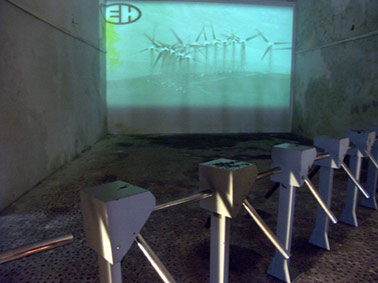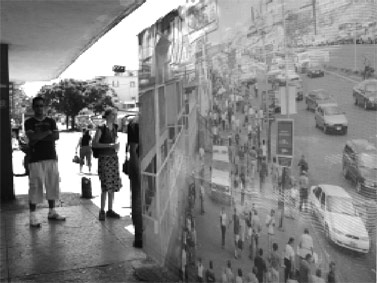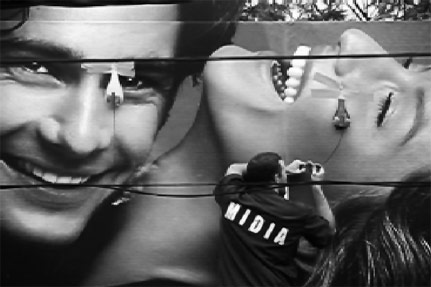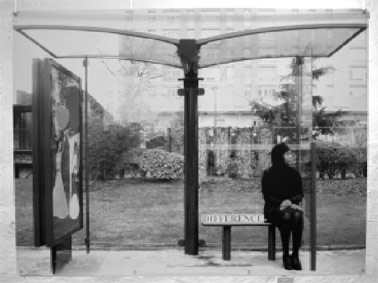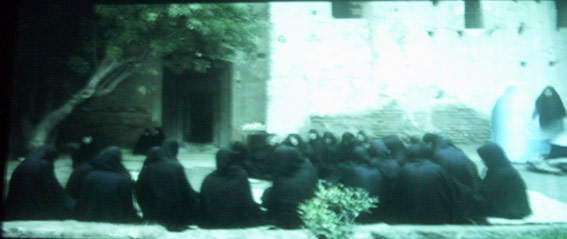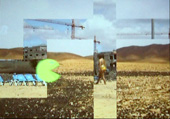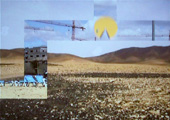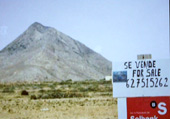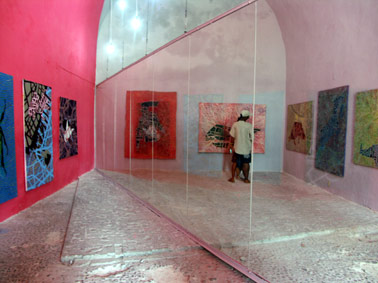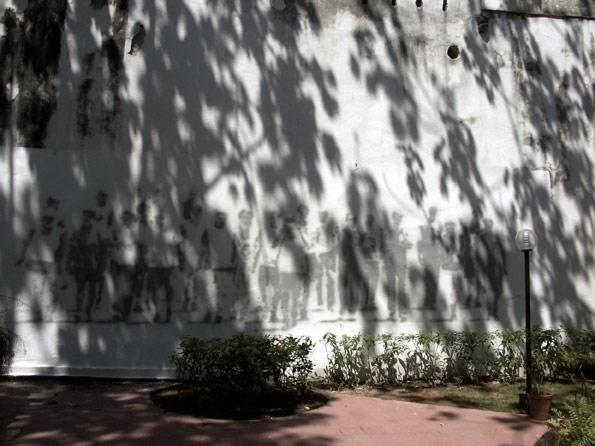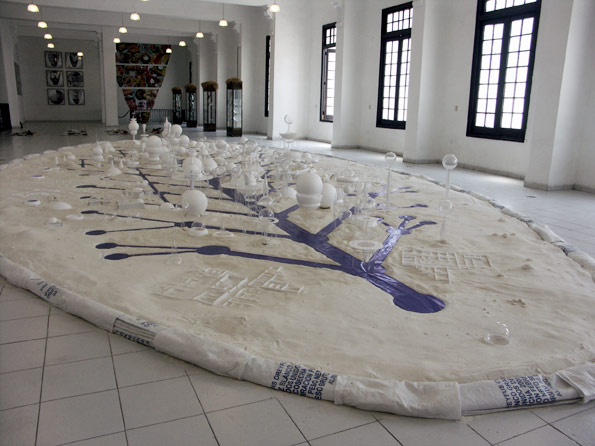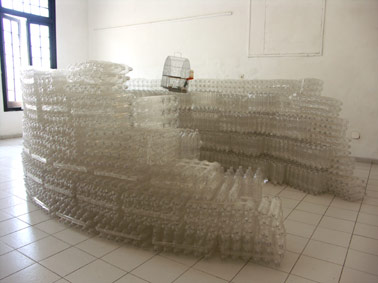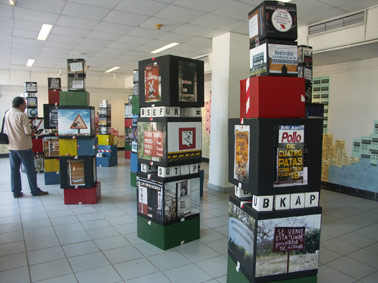Edgar
Hechevarría (Cuba): Energi, installation
/ PHOTO: Ximena Narea
|
Several
weeks after its culmination, the 9th Biennial in Havana is still the
subject of conversation in the art circles, at least in Cuba. I will
undertake its analysis without having an overall evaluation from the
curators’ collective, which presupposes a partial judgment.
However, I assume that my reflections will be shared by some of my
colleagues.
The
texts of the curators Herrera Ysla and Noceda Fernández –
published as essays in the General Catalog and reproduced in this
issue of Heterogénesis – explain why the subject “Dynamics
of the Urban Culture” had been chosen. Thus, my evaluation
will focus on the events “before and after”, summarizing
the curatorial, discursive and other coordinates finally put the
event together, informing about the changes and adaptations experimented
by the original platform and determining to what extent the thesis
put forward by the Biennial was fulfilled.
If
the subject of “the Urban Culture” at first met resistance
from some members of the Curatorial Team, since it already had been
dealt with by other similar events in other parts of the world,
it was later approved, among other reasons, because it allowed for
a continuity on the thematic and linguistic interests, as well as
to the attempts to give some dynamism to the structure of the events
carried out during the 7th and 8th Biennials. These three aspects,
and their accomplishment to the originally projected degree and
aesthetic level – a point which wasn’t achieved as it
was intended and would be the cause of criticisms of the Biennial
– gravitated on the materialization of the general concept
conceived for this edition, as well as the possibility of perpetuating
the specific profile of the Havana Biennial: the validation of the
contemporary art of the so-called “South” on a plane
of equality with today’s production in the so-called international
circuits.
I
don’t think it is necessary to describe once more the phenomena
and transformations that led us to situate the urban cultures on
the focus of our attention, since the above mentioned curators already
have taken on the task. It is a subject with some contours already
anticipated in the two previous editions in respect to the interest
shown of the public projection as well as of the participation of
the citizenship in some kinds of art, and other kinds we considered
should be more widely considered from a “glocal” perspective
– e.g. the focusing on situations and particularities of urban
cultures in regions of unfinished modernization in the context of
globalization – in the light of varied tools and practices
including the new media, effective conveyors of the vertigo and
fleetingness of urban life and tempo.
|
|
|
| Maggy
Navarro & Angela Bonadies
(Venezuela): Mobile Space - Caracas-Habana
PHOTO:
Centro Wilfredo Lam Publications Staff
|
The
various approaches to the urban universe and their public nature,
as well as the difficulty to frame the polysemy of some physical and
spatial concretions of traditional works, actions and projects in
situ, led us to decide on an open curatorship – not fractioned
by thematic nuclei, where the problems of the urban cultures of the
so-called “South” would play a fundamental role. This
openness also took into account the increase of the diversity of the
participants with the aim of making a dialog between the urban realities
of the “South” and the other areas of the planet possible.
It was on these premises that we set ourselves out to put forward
our points of view and a peripheral attempt to deal with “a
subject of universal nature and participation”, as well as to
confront conflicts, reflections, practices, imaginaries and gazes
from various latitudes.
Let us see how our ideas were implemented, their achievements and
shortcomings.
Besides
the motives exposed in my article “Frag-mentos de arte y vida
en la Octava Bienal”(1) with res-pect to the
changes in the group of participants, the actual conditions of interdependency
among the various regions and countries stemming from the planetarization
of a political, economical and informational model conspired against
the geographic delimitation of such a universal and interconnected
subject as the dynamics of the urban culture. The cosmopolitan nature
of the city – with no regard to the level of development of
the country involved – and the phenomenon of migrations with
all its charge of Besides the motives exposed in my article “Frag-mentos
de arte y vida en la Octava Bienal”1 with res-pect to the changes
in the group of participants, the actual conditions of interdependency
among the various regions and countries stemming from the planetarization
of a political, economical and informational model conspired against
the geographic delimitation of such a universal and interconnected
subject as the dynamics of the urban culture. The cosmopolitan nature
of the city – with no regard to the level of development of
the country involved – and the phenomenon of migrations with
all its charge of contamination of cultural behaviors, demanded a
more comprehensive and international perspective of its approach.
Considering the actual state of the planet, constraining ourselves
to the peripheral orb would mean to leave aside the cause, explanation
and (place of) origin of the problems now surfacing in the capital
cities of our countries having their corresponding expression in cities
in other parts of the world and vice-versa, leaving the treatment
of other problems unfinished in their own territories and outside
their borders. Economic crisis, situations of survival, migratory
flows, multiculturalism, migration from the countryside to the cities
or towards urban centers where there are more jobs, constitute a chain
of events that coexists with and influence the demographic implosion,
the re-sketching of the urban-environmental cartographies and the
endless expansion of the borders of the cities which, in the developing
countries, teem with favelas, cerros, shantytowns and other peripheries.
As
a reflection of the world, art has been portraying some of the manifestations
I have referred to, and it has even brought the development of some
pheno-mena beyond the geographic boundaries it was intended to confine
itself in to public light. In this respect, the Biennial showed the
curious version of migration within the “South” in the
projects of Sue Williamson from South Africa and of Rosalía
Maguid from Argentina: The former consisting of off-voice narrations
of interviews with African immigrants from neighboring countries who
reside in Cape Town (Africa within Afri-ca) while television screens
reproduce the interviewed listening to their own recordings, and the
latter on the ingenious advertisement strategies practiced by Asian
communities to promote their shops and restaurants in order to achieve
integration (or to get acceptance?) in Buenos Aires’ and São
Paulo’s societies. The compulsive demographic growth, the crowding
of buildings and the territorial expansion of the orbs could not have
been depicted better than in the big format bi-dimensional work of
Dimitri Tsoublekas from Greece, and of Michel Najjar from Germany.
The photographic ensemble of Carlos Germán Rojas, though charged
with a loving gaze towards the relatives and friends from his natal
barrio on the side hills of Caracas, touches on the subject of the
saturation of their narrow streets and spaces twenty years later.
The proliferation of precarious forms of settlement in Africa, their
nomadic character, their chaotic and improvised development until
its networkings and vehicular traffic reach the appearance of a micro-city,
was the subject of the video of the SenegalesDouts_Mohamadou N’Doye
– an animation made out of the simple material of paper cuttings.
|
| |
|
Eduardo
Srur - Brazil
- Atentado, 2004
PHOTO:
Centro Wilfredo Lam Publications Staff
|
In previous editions, we became aware of certain works that used to
coincide in the focus of their objective as well as in the means used
to achieve it – a coincidence that should not always be interpreted
as copies of the art produced by the so-called centers. Jaime Castro
(from Venezuela) and Rodney Glick (from Australia) exemplify the use
of technological means and similar objectives. The urban landscape
is sketched by them from the point of view of its fragmentation, achieved
by the simultaneous recording of the environment with multiple video
cameras allowing them to cover as many spaces as those covered by
the control panels of surveillance systems created for other purposes
in a kind of open air panopticum.
Albeit
we have grouped the proposals according to the similarities in their
discourses in this evaluation, in the real event they were not shown
in that order. As with the 8th, this Biennial paid no heed to a discursive
structure based on thematic nuclei or sub-themes like in previous
editions, as in the 5th and the 6th, had facilitated the reading of
the main lines of the central message. The difficulty of reconciling
the characteristics of the works with the peculiarities of the spaces,
to a high degree concentrated at the Fortaleza de la Cabaña,
had a strong influence on the decision made, even with regard to the
reasons that led us to opt for an open curatory. However, the opinions
expressed by the public and the local critics imply that the encompassing
sense of a discourse structured around the reunion of a considerable
number of international works dealing with foreign realities, local
works and projects scattered all over the city as parts of a whole
was not perceived. It is evident that the compartmentalization of
the spaces and the lack of the textual supports – a resource
not absent from the first biennials, especially at sites such as the
National Museum – also conspired against the comprehension of
the curatorial concept.
Had
the traditional disposition of the works by sub-themes – a task
performed by the curatorial board – been followed, then the
redundancies of certain to-pics and formats would have surfaced, and
perhaps the result would have been different, in spite of the last
time replacements of works made by some of the artists. The urban
landscape was the most repeated topic, and it put a perhaps excessive
accent on the orb’s physical space, which was not among our
priorities (specially, to the extent it was actually shown). Besides
Glick and Castro, I will add the names of Amal Saade (Lebanon), Dionne
Simpson (Jamaica), John Kotzé (Zimbabwe), Oscar Bonilla (Uruguay),
among many others with varying aesthetic and connotative results.
To this group I should add Raquel Schwartz (Bolivia), Akimbode Akibinyi
(Nigeria) and Pedro Abascal (Cuba) for their photographies of popular
markets and street show windows, fragments of the landscape of the
city joined together by the visual aspect of consumption in peripheral
countries.
Other
proposals surpassed their representations as mere settings, territories
or sceneries, and focused on the – social, ecological, environmental,
cohabitational – conflicts of the contemporary orb, the microcosms
and cultural imaginaries and transformations of some cities. The Brazilians
Cinthia Marcelle and Eduardo Srur exposed facets of the urban reality
through questioning comments: The former, through a video showing
the acrobatics unemployed youths in the streetlights of the city are
forced to do in order to make a living; the latter, through another
video conveying a refusal of the fictitious ideal of the ad walls
by detonating explosives on the faces of their mo-dels. Housing problems
and social exclusion were dealt with by Yenniffert Becerra from Chile
with the hand-made lightness of installations made with cord. The
popular latino taste reverberates in the allegories of the ambient
of the techno-cumbia in the photographies of Ecuadorian Miguel Alvear;
the lyrics of the boleros and the kitsch style of the “streetwalkers”
reflect the male preferences in certain circles. The alternation of
highly over-dimensioned faces in close-up – highlighting the
ethnic traits of the Haitian population – with big color landscape
photographies of street corners in Port au Prince of emblematic third
world characteristics strengthens the recursiveness of this kind of
homologation, used under an aura of exoticism by some books and magazines
of ethno-geographical character. A peculiar use of perspective to
reinforce an opposite reading is seen in the pairs of photo-graphies
of the American born Chinese Sze Tsung Leong – a framing that
makes the drastic changes taking place in the transformation of the
suburbs of the Asian country into organized residential areas more
conspicuous. The environmental problems were well-represented by Eder
Santos from Brazil and by the BGL Group from Canada. The former, with
a video-installation about the environmental damage caused by the
extermination of plant life, showing birds forced to stand on the
wires of public lighting because of the lack of trees, and the Canadians,
on the lethal effects of pollution staged through the death of a man
that transforms himself into a car: a pool of oil on the floor as
if it were a pool of blood, pouring from a black car in whose interior
a flame in the motor points at the hydrocarbon as its cause. Although
to a lesser extent, other relevant topics were dealt with in the Biennial:
The non-identity, the radical transformation of the territories and
the internalization of cultures brought about by the tourism-related
housing investments in the Canary Islands gave life to Javier Camarasa’s
proposal, a video installation in two bodies, one of which consisted
on enjoyable songs of prodigal irony.
|
|
Michele
Magerma (Democratic Republic of Congo): Good by Rosa, 2006
PHOTO: Centro
Wilfredo Lam Publications Staff
|
The
Cuban representation was heterogeneous with respect to the importance
and symbolic potential of the works, and in my opinion the works that
stood out were those taking up subjects that were new or seldom dealt
with, some of them with explicit reference to concrete social problems,
and others with a more elliptical treatment of reflections of almost
worldwide span. Alejandro González’s black and white
photographies belong to the first group: they draw the attention to
the conduct of those marginal beings – alcoholics, freaks, travesties,
etc – meeting at dusk in Havana’s malecón. The
most original works were those contributed by Eduardo Ponjuan and
Edgard Hechevarria. The fragility of commercial relations and China’s
outstanding position within the world market constitutes the essence
of Ponjuan’s proposal, materialized in the relationship established
between the title of each work and the full-size display of huge wrappers
of Yutong locomotives from that country arriving to Cuba. Hechevarria
on his part brought up a topical issue: the obstacles to the extraction
of energy, a source of progress, through the interplay of a row of
turnstiles to control the circulation of the public across the hall
and the large scale projection of a video on a wall reproducing electric
windmills in crescendo, always spinning in the same direction.
Except
for Ponjuan’s proposal, which was shown at the Casona, the selection
of the commented works, even those from Cuba, were exhibited at the
Fortaleza de la Cabaña, whose spaces sheltered about 70 % of
a total of 152 works presented. However, there were some pavilions
in this colonial-style location where regrettable mistakes of museological
character, of disposition and quality of the proposals, and even of
their suitability to the space were noticeable. Such was the case
of Cuba-Brazil, a project of public and communitarian character representing
a form of action with a socially inserted orientation – emasculated
by inconvenient interventions – having as a main tool of expression
the art of spraying, whose traits of graffiti, expressionistic configurations,
kitsch and media elements for open spaces and street walls resulted
grotesque and completely inapropiated for that space. Another case
is Arquivo Brasilia, a collection of photographies whose testimonial
value was eroded by the precarious treatment and presentation by the
Berlin curators who provided the proposal. Other shortcomings were
produced due to production problems, the repetition of bi-dimensional
formats due to the abundance of photographies and videos in a narrow
space such as the aisles at La Cabaña, and to substitutions
of works, as in the case of Pablo River from Chile, an artist who
has achieved international prestige thanks to his ambiguous objects
and minimalistic sculptures – some of architectonic format –
for public spaces, being this the reason why he was invited, but he
couldn’t take the works with him because of the lack of resources.
For the same reason we couldn’t show the excellent work of the
Africans Gonzalo Mabunda from Mozambique and Samuel Fosso, from the
Central African Republic, who were selected because of their ironic
transculturation of cultural respectively constructive archetypes:
Mabunda (2) by his versions of the Eiffel Tower,
park benches and other sculptures made with weapons, in a direct reference
to colonialism’s robbery and plunder, and Fosso with his self-portraits
in which he, through the camouflage of his own image, recreates genres,
prestige positions and professions by the imitation of Western attitudes
and poses.
.
|
|
| Shirin
Neshat (Iran-USA): Zerin, 2005. Video |
The
concentration and preeminence of videos – digital installations,
photographies and prints – at La Cabaña wasn’t sufficiently
balanced with other visual manifestations and grammars: sculptures,
objects, installations and outdoor works that could have brought a necessary
variety of ideas and attraction to this market-like space. On one hand,
this result evidenced the importance given by the artists and their
mastering of video- and technological tools while dealing with works
of critical-conceptual character, a discursive approach which has given
this event fame for being self-reflecting(3). On the
other hand, it went against our original purpose of making more room
for the artistic typologies that promote citizens’ participation
as a way of activating the bridges between art and life: workshops,
process-oriented and transdisciplinary projects with character of spectacles
– aims that acted as our conceptual compass and at the same time,
the tactical devices intended to carry out our ideas. But, let’s
look at the reasons why the Ninth Biennial could not be implemented
as it was intended.
From the beginning it was conceived
as based on workshops and process-oriented works, or at least this
kind of works playing a fundamental role in it – an idea which
was born out of the success of the Isaroko Workshop at the lot of
La California, as well as the intervention project Mover las Cosas
in 14 apartments in a building at Alamar during the Eighth Biennial
– the Ninth was very soon forced to desist from that (original)
platform almost at the organizational stage. On one side, during the
curators’ study trips in order to preselect the list of participants
to the Biennial, it was detected that the works conceived for gallery
spaces still prevailed in many countries. On the other, carrying out
workshops, projects on the spot and the so-called “actions”
- a typo-logy in which the contextual aspects play a fundamental role
– demanded a longer stay of the artists or artists’ collectives
in Havana, or at least more than one visit to the country. They argued
in favor of the need of more knowledge about the Cuban reality in
order to work on adequate meanings for their actions and, in the case
of the works on the spot, for the (knowledge about) the particularities
of the space to intervene in order to get inspiration from or to adapt
their proposals to it, but our budget wasn’t big enough for
that.
This
last factor, together with obstacles deriving from existing urban
regulations, and the reticence (or refusal) from the authorities with
decision power upon the use of public buildings and spaces in the
capital’s municipalities to accept artistic proposals destined
to the streets due to their difficulties to assimilate the codes and
languages of contemporary art, forced us to abandon the idea of conceiving
the Biennial as parting from a structure based on public actions and
workshops.
|
|
Shirin
Neshat (Iran-USA): Zerin, 2005. Video |
Also, because of budgetary – or sponsor-related – reasons,
we were forced to do without the participation of interdisciplinary
proposals closely connected with the principles of the spectacle,
which would have diversified the linguistic models and would have
illustrated the dynamics of urban cultures, giving color and a profile
of renewal to the event as it was first intended. Those were NORTEC
from Tijuana (at the border between Mexico and the US) and Caja Lúdica
from Guatemala. To this two I would add the Parade of Instituto de
Moda Bivril from Caracas, based on fashion designs of street wardrobe
and urban prototypes created by the designers of that institute, a
show that was intended to have a rap music background and the participation
of “real” street counterparts to the professional models
wearing the clothes: the street vendor, the student, the waiter, the
construction worker, in order to propitiate an unusual confrontation
between creation and reality.
In
spite of such absences that affected the thematic conception of the
event, 49 countries participated in the Ninth Biennial (a somewhat
larger number than in previous editions). Apart from the openings,
the program of the first week was composed by the Workshop on Alternative
Wardrobe, the theoretical symposium organized under the title Forum
Idea 2006 and the cycle Ciudad Video. Other sites of the Biennial
were also the Cuba Pavilion – a space where some of the activities
of the Workshop on Alternative Wardrobe were held – and several
institutions at Old Havana where the works of the special guests were
exhibited: the Wilfredo Lam Center, the Casa de México, the
Villena Gallery, the Fototeca de Cuba, the Hispanic-American Cultural
Center, and the Salón Blanco at the San Francisco cloister.
The
process-oriented and/or on-the-spot projects concentrated around Old
Havana, although few, they fulfilled our expectations and arose the
attention of the public. The Salón Blanco [White Hall] showed
the work of the French artists Anne and Patrick Poirier, and of the
Catalonian artist Antoni Miralda. The Poirier’s project, A new
white project for a white planet at the White Hall is a classic example
of a work on the spot made for an indoors space, exclusively made
for the Havana Biennial. Paradigmatic in the production of large scale
models since the beginnings of the art of installation – a genre
in which their pioneering role in the 70s is acknowledged –
the Poiriers confess the inspiring force of memory as a founding detonator
for their works as well as their historical roots in the memories
of their devastated home town after the World War II, an always renewed
experience depending on the context and place
undergoing the intervention. According to the
artists, the proposal emerged from the creative integration of natural
local referents to the futuristic fiction of the white city of a planet
discovered on the year 3235. The oval silhouette of the leaf of a
tree in the Cloister served as a plane for the futuristic city while
the white and dusty nature of sugar – a product that represents
our main national industry – covered and formed the topography
of the planet. Satellite-like structures and other buildings based
on spheres and flattened domes resembling flying saucers in polyethylene
and transparent plastic functioned as by then already vanished buildings,
houses and skyscrapers. Facing this macro-installation, a wide tower
made with plastic bottles similar to
the Coliseum, established a confrontation between past and present
architectonic archetypes.
|
|
|
|
|
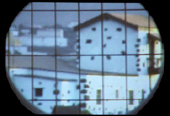 |
|
Javier
Camarasa (España). Sun and buiding/ 2003. Video |
Another macro-installation, the itinerant, process-oriented and collective
project Sabores y Lenguas of Antoni Miralda(4), occupied
the other part of the hall. Through the provoking visual characteristics
of the “Eat-Art”, and aware of the traditional and identity-oriented
character of cuisine culture and of the extent to which its invocation
can counter the homogenizing action of globalization, Miralda succeeds
in achieving the spectators’ active participation, who besides
are stimulated by the presence of everyday elements of their gastronomic
culture among the exhibited items. The sections composing the installation
were: combo mix, urban cuisine topography, linguistic wall paint,
city tongues, and the Latin American imaginary dinner service are
reformulated according to the realities of each of the thirteen Spanish-speaking
cities where the project is exhibited. In Havana, the displayed cases
exhibited separately small size paintings of “tongues stabbed
through by a dagger” (a local symbol referring to calumniation),
household objects of everyday used in the Cuban kitchens, from simple
hand-made imitations to those industrially produced, plus the basic
set of consumption goods guaranteed to the population through the
ration book – all these being very familiar objects to a public
who enjoyed seeing them exhibited as museum objects. Two huge tongues,
one from Latin America and the other one from Havana, composed of
photographies of typical dishes from each city, revealed the gastronomic
preferences and taste buds of the various places, complemented by
photos of coffee shops, peasant markets and restaurants. Meanwhile,
the blackboard on which the public wrote sayings and phrases associated
with food and its symbols, and the dishes placed on the ground to
form a giant tongue – of which a part were dishes used in exhibitions
in other cities, and the rest had been gradually intervened by the
artists and the public – gave the project the participatory
and “in-progress work” character we were interested in.
In
a small annex space to the Salón, the Berlin-resident Norse
Sissel Tolaas showed Havana mi amore, an interactive project that
is part of her studies on the smells of each city. The impossibility
of making a reconnaissance trip in order to know the smells the people
of Havana identified as belonging to their city forced her to re-adapt
the project. She brought with her jars with the smells with which
Berliners “imagine” Havana: sea, tobacco, coffee and sweat
(the latter impregnating a wall that was activated by touch). Meanwhile,
the “real” smells were brought by the audience from Havana,
who wrote them down on sheets of paper placed on a table for that
purpose.
|
|
|
|
Ibrahim
Miranda: Catharsis / Installation - PHOTO:
Ximena Narea |
One
block away, in an ambient constructed as a movie theater, at the Fototeca
de Cuba, the work Zarín was presented, one of the last videos
of the renowned artist Shirin Neshat. Inspired by the novel by Sharhnush
Parisupur “Women without men”, the film confirms the re-orientation
of her films towards a more emphatic, agile and powerful work with
the narrative sequence in substitution of her previous accent on visual
symbolism insisting once again upon her subject of interest: the conflicts
of women in Arab cultures and societies. The shame, horror and psychic
suffering of a young woman who has been forced to make a living as
a prostitute, the alienation caused by submission to a situation without
escape are masterly directed, from the beginning of the short film,
intensifying the dimension of the conflict in the protagonist’s
behavior in various situations. An approach to a dilemma and a cultural
reality that do not seem to even have been “touched” by
the worldwide spread of Western culture.
Among
the projects of urban intervention I would like to highlight Havana
Gold by the Fa+ duo from Sweden, composed by Ingrid Falk and Gustavo
Aguirre. It consisted of covering the lids of manholes, sidewalks,
drains and trashcans in a block of the San Ignacio street with golden
paper, as a way of magnifying and calling the attention upon the functional
elements of the public streets not sufficiently noticed compared to
the care dispensed to those of decorative character in Colonial Havana.
Relatively near, on an abandoned lot between two buildings, the Cuban
Rigoberto Mena presented his project Convivencia, a term that sums
up his intention of making art live together with reality by placing
his proposal right in the middle of reality: the walls of the city.
Impeccable photographies reproduced the ruinous appearance of the
walls they hung on. In front of them, big metal plates were the support
of his pictorial abstractions about the passing of time on those walls,
while those on the background superimposed to their condition of “abstract
walls” several electricity meters – the real object.
Havana
Gold suffered a fate similar to Espacio Móvil: Caracas-Havana,
an intervention on buss stops with giant digital photographies reproducing
images from Caracas: their exhibition lasted a very short time. Other
proposals for the urban space were carried out under the established
terms. Museo Peatonal, an itinerant institution created by a duo composed
by a Mexican and a Dominican artist and successively presented in
various zones of the city, the action El Arte Purifica, of the Cuban
Carlos Montes de Oca with the collaboration of the street cleansing
enterprise Aurora, and the art interventions of a bus and two “camels”
- appellative given in Cuba to a means of public transportation whose
structure imitates the back of the famous animal – the first
one as part of the project Espacio Móvil: Caracas-Havana, and
the other two carried out by the artists Guillermo Ramíez Malberti
from Cuba and Guarací Gabriel from Brazil, respectively. The
intervened vehicles still circulate the streets of Havana in that
condition.
Old
Havana gathered the exhibitions with the largest number of visitors:
those at the Salón Blanco, Cartele at the Villena Galery and
Spencer Tunick, at the Wilfredo Lam Center. The affluence of visitors
to the exhibition of street signs selected by the three Argentinean
designers members of the Cartele art collective showed the importance
of humor and the absurdity of communicational enterprises. For us,
however, the invitation of Cartele fulfilled other objectives: to
give importance to the popular street culture in relation to the standardized
advertisement. The photographies of Spencer Tunick from USA, recording
naked multitudes in public spaces of various cities shocked the public
and illustrated the performatic and massive character of the citizens’
participation in the process of his work. It must be made clear that
his invitation to Havana never contemplated the realization of photographies
of that kind in Cuba; however, many of the attendants expressed their
disposition to take part in those (human) landscapes unified by nudity,
a condition that reduces them to their natural condition: that of
human beings.
|
|
|
|
Mariano
Molina (Argentina): Cut, 2006. Wall painting
PHOTO: Centro
Wilfredo Lam Publications Staff |
Works of sophisticated manufactures as Tunick’s photographies
living side by side with a collection of improvised street signs representing
the popular culture, explain the curatorial principles of this Biennial
giving the same importance to both expressions, without regard to
their visual universe. In their character of collective projects we
invited Omni Zona Franca and Jaimanitas, “living” expressions
of our own urban culture, of peripheral and alternative character,
and which would be pointless to exhibit in a place different from
where the work emerges and exists. The underground nature and the
popular character of an ambient work usually taking place at the level
of the barrio were not arguments against their inclusion, since the
first biennials gave space and acknow-ledged to popular culture as
a part of the contemporary culture of the now extinct Third World,
an edition now dedicated to the urban cultures should not fail to
notice phenomena such as Omni and Jaimanitas.
Omni
is a kind of cultural product emerging in a peripheral barrio, Alamar,
from the pulsations of its eve-ryday life and from a life philosophy
expressed through the precariousness of the recyclable object, the
irreverence of rap music and the mural paintings, but also through
the use of video and digital tools. Jaimanitas on their part are an
example of artistic work in the benefit of a community after 10 years
of existence under which the facades, roofs and walls of their buildings
have been invaded by fantasies of José Fuster’s naive
style of Gaudian trademark in collaboration with his neighbors. This
“guajiro [Cuban pea-sant] from the coast” as he calls
himself, has given ceramics, particularly the mosaic, an unprecedented
constructive-decorative quality by endowing his rural and maritime
allegories built with those materials with functional ends. During
the Biennial he inaugurated a pu-blic mural painting based on mosaics
intervened by a group of Cuban artists invited by him.
|
|
|
|
Anne
& Patrick Poirier (France): A new white project for a new white
planet in the White Room. 2006. Installation
PHOTO: Ximena
Narea |
At the antipodes of these universes of local culture and their constructive
enclaves, we find the work of Jean Nouvel, the internationally renowned
architect winner of important awards (5) and considered
as one of the most important in the world. The four walls of the Hispanic-American
Cultural Center were covered up to the roof with a huge retrospective
collage – a photographic overview of his monumental architectonic
work up to the present, including never executed projects. The public
visiting at the opening day could enjoy a dissertation of Nouvel,
who in front of his works explained why “contemporary architecture
should value context,” “the architecture of light”
and the impact of this element through the finely tuned complementation
of material, technical innovations and constructive locations, together
with other criteria underlying his Louisiana Manifesto, reproduced
in large scale on the floor as a part of the exhibition. In an interview
with the critic Andrés Abreu, Nouvel defines architecture as
“the most visible face of art, because we can find it in the
streets...” That is why we considered appropriate the participation
of an architect whose legacy has enriched and transformed the physiognomy
of several cities: consider Barcelona and its Agbar Tower, Copen-hagen
and its building of the Philharmonic Orchestra, and Nantes and its
Court of Law...
The
gathering of an ample representation of international works on various
subject-related topics, local works, some projects on the spot, “living”
experiences of our urban culture and the ultra-modern achievements
of an architect of world-wide recognition as Jean Nouvel, is the best
way of attaining an unbiased encompassing of the diversity of urban
cultures, their interconnections, their common aspects and their contrasts.
Once again the Biennial established its stance through the curatorial
selection, in spite of the precariousness of some projects, the excess
of bi-dimensional works and the disproportionate, respectively inappropriate,
space given to some topics conspiring against the artistic level of
the event and blurring its general reading. Although the above explained
difficulties made it impossible to develop a curatorial work that
would be more invasive of the urban space, it is nevertheless true
that this Biennial increased its public thanks to an unprecedented
work of diffusion in the media. As well as the laudable effort of
design and edition of the Catalog in charge of a team at the institution
– a task not being carried out in Cuba since the Third Biennial.
|
|
|
|
Anne
& Patrick Poirier (France): A new white project for a new white
planet in the White Room. 2006. Installation
PHOTO: Ximena
Narea |
The
same can be said about the theoretical symposium Forum Idea 2006:
Attended by key figures of international thought, and (lesser- or
non-internationally renowned) lecturers, who from their respective
fields and perspectives contributed with substantial reflections to
the analysis of contemporary transna-tional, regional and local experiences
on the subject. There is much to be said about the various lectures
of the program, but I would like to at least highlight those dealing
with instructive proposals of discourses contrary to the hegemonic
narratives, both on known artistic typologies and on art works of
recent production.
The
operation of situating on a plane of equality the axis of “north
and south”, and with it their respective problems and utopias
or, which is the same, the equal recognition of works from our regions
with those originated in the First World on the subject, would be
the strategy that would sustain the thesis of this Biennial. In this
sense, we have achieved our goal.
|
|
|
|
CARTELE
(Gastón Siberman, Machi Mendieta & Esteban Seimandi, Argentina)
Installation 2006
PHOTO: Ximena
Narea |
|
NOTES
1 Sánchez
Prieto, Margarita: “Fragmentos de Arte y Vida en la Octava Bienal”.
Atlántica, Islas Canarias, Nr. 34, winter 2004, pp. 20-30
2 Mabunda’s
work arrived almost at the end of the event, a few days before its
closure.
3 This
is not an isolated case. We know of some noticeable examples of recent
production in some countries of Latin America. Also in the last edition
of the Show of Contemporary Art in Havana we could notice a tendency
towards greater and more efficient use of video in works of neo-conceptual
character.
4 Antoni
Miralda has a vast trajectory in which his experiences in commercial
photography, fashion, object art, actions and performances intertwine
towards the production of large scale works of public and international
transcendence. Remember his tour of the streets of Paris with a copy
of the Victory of Samotracy covered with little white soldiers as
a protest against the Vietnam War, and the symbolic celebrations of
Christopher Columbus marriage with the Statue of Liberty in various
nations through the union of various objects in the same huge scale
of those figures.
5
Among others, the Grand Prix d¨Architecture from 1987, the Special
Mentions of the Aga Khan and the Equerre d¨Argent prices.
|


